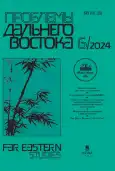Rare Earth Elements and the Geopolitical Significance of BRICS
- Autores: Safronova E.I1
-
Afiliações:
- Institute of China and Contemporary Asia of the Russian Academy of Sciences
- Edição: Nº 6 (2024)
- Páginas: 74-90
- Seção: Economics
- URL: https://journal-vniispk.ru/0131-2812/article/view/280014
- DOI: https://doi.org/10.31857/S0131281224060058
- ID: 280014
Resumo
Palavras-chave
Sobre autores
E. Safronova
Institute of China and Contemporary Asia of the Russian Academy of Sciences
Email: safronova@iccaras.ru
ORCID ID: 0000–0002–4256–2381
Ph.D. (Economics), Leading Researcher, Centre “Russia, China, the World” Moscow, 117997, Russian Federation
Bibliografia
- Kalantzakos S. Redkozemel'nye elementy i geopolitika Kitaya
- Kryukov V.A., Yacenko V.A., Kryukov Ya.V. Redkozemel'naya promyshlennost' — realizovat' imeyushchiesya vozmozhnosti
- Olejnik I.L. Povyshenie glubiny pererabotki fosfatnogo syr'ya s poputnym izvlecheniem redkozemel'nyh metallov. Diss. kand. tekhn. Nauk
- Petrovskij V.E., Filippova L.V. Rossiya i Kitaj v Arktike
- Dantas B., Henrique Cochi H. et al. BRICS detém 72% de reservas globais de terras raras, mas não pos- suem estratégia conjunta para aproveitamento industrial // Observatório de Política Externa e da In- serção Internacional do Brasil. Outubro 24, 2024. URL: https://opeb.org/2024/10/24/brics-detem-72-de-reservas-globais-de-terras-raras-mas-nao-possuem-estrategia-conjunta-para-aproveitamento-industrial/ (дата обращения: 22.11.2024).
- De Medeiros, Carlos Aguiar; Trebat Nicholas M. Transforming natural resources into industrial advantage: the case of China’s rare earths industry. Transformando Recursos Naturais em Vantagem Industrial: o Caso da Indústria de Terras Raras na China // Brazilian Journal of Political Economy. URL: https://www.scielo.br/j/rep/a/KmfcjxBFKvyrjHjDXBkLsNq/?lang=en (дата обращения: 25.10.2024).
- Gili A. & Tentori, D. The Fight for Global Technology Leadership // The Comeback of Industrial Policy: The Next Geopolitical Great Game (ed. A. Gili & D. Tentori). Milan: Istituto per gli Studi di Politica Internazionale (ISPI). 2023. Pp. 13–73.
- Goonan T.G. Rare earth elements: end use and recyclability // Scientific Investigations Report 2011–5094. URL: https://pubs.usgs.gov/sir/2011/5094/pdf/sir2011–5094.pdf (дата обращения: 25.11.2024).
- Gschneidner K.A., Jr. The Rare Earth Crisis — The Supply/Demand Situation for 2010–2015 // Rare Earths — Crucial Elements of Advanced Technologies. Material Matters. 2011. Vol 6. No. 2. Pp. 32–41.
- Hayes-Labruto, L., Schillebeeckx, S.J.D., Wordkman, M., Shah, N. Contrasting perspectives on China’s rare earths policies: Reframing the debate through a stake holder lens // Energy Policy. 2013. No. 63. Pp. 55–68.
- Jepson N. A 21st Century Scramble: South Africa, China and the Rare Earth Metals Industry // Acade- mia.edu. URL: https://www.academia.edu/2998703/A_21st_Century_Scramble_South_Africa_ China_and_the_Rare_Earth_Metals_Industry (дата обращения: 25.11.2024).
- Kalantzakos S. China and the geopolitics of rare earths. New York: Oxford University Press, 2018, 240 p., ISBN 9780190670931; China and the Geopolitics of Rare Earths // Oxford Scholarship online. No- vember 23, 2017. URL: https://academic.oup.com/oxford-scholarship-online/search-results?page=1&q=%20China%20and%20the%20Geopolitics%20of%20Rare%20Earths%20Sophia%20Kalantzakos&fl_SiteID=6556&SearchSourceType=1&allJournals=1 (дата обращения: 17.12.2024).
- Martins, Tiago Tecelão. Geopolítica de Terras Raras e a China Novos capítulos no Ártico // Observa China. Janeiro 23, 2024. URL: https://www.observachina.org/articles/geopolitica-de-terras-raras-e-a-china (дата обращения: 12.11.2024).
- Ranjan A., Donnellon-May G. The political gaps in the BRICS wall // East Asia Forum. Peer reviewed analysis. November 22, 2024. doi: 10.59425/eabc.1732269600
- Samsonov N.Yu, Tolstov A.V., Pokhilenko N.P., Krykov V.A., Khalimova S.R. Possibilities of Russian hi- tech rare earth products to meet industrial needs of BRICS countries // African Journal of Science, Technology, Innovation and Development. 2017.Vol 9. Iss. 5. Pp. 637–644.
- Thompson K. There is no substitute // Popular Mechanics. 2013. Vol. 190. No. 1. P. 60–93.
- United Nations Conference on Trade and Development // Commodities at a Glance: Special Issue. 2014. No. 5. 48 p.
- 中华人民共和国科学技术进步法 [Закон Китайской Народной Республики о прогрессе в области науки и технологий] // 中国政府网. 25.12.2021. URL: https://www.gov.cn/xinwen/2021–12/25/content_5664471.htm (дата обращения: 25.11.2024).
- 叶莲娜·萨福洛诺娃: 西方制裁俄罗斯背景下的金砖合作 [Safronova E.I. BRICS cooperation in the context of Western antiRussian sanctions] // 东北亚论坛. 2023 年. 5号(俄罗斯智库专家论新形势). 第24–29页.
- 朱建喜: “工业味精-稀土”— 我国稀土资源概况 [Чжу Цзяньси. Редкие земли — «витамины» про- мышленности. Обзор редкоземельных ресурсов нашей страны] // 中国科学院广州地球化学研究所, GIG. 12.10.2021. URL: http://www.gig.ac.cn/kxcb/202110/t20211012_6221301.html (дата обращения: 22.11.2024).
- 稀土, 你了解吗? [Что вы знаете о редкоземельных элементах?] // 自然资源部中国地质调查局成都矿产综合利用研究所科普文章选登 (一), 中国地质调查局. 22.04.2020. URL: https://www.cgs.gov.cn/ddztt/jdqr/dqr51/jzsdwhd/202004/t20200422_632084.html (дата обращения: 22.11.2024).









